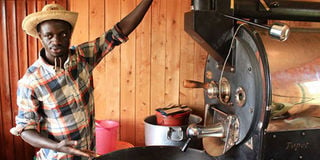Guided excursion of a coffee estate

David Andayi, a staff at Mbumi Coffee Estate in Kiambu, demonstrates to visitors how coffee is roasted. PHOTO | JAN FOX
What you need to know:
- Coffee became a major commodity under British rule, and settlers had exclusive control over production until 1933.
- The green cherries are sun-dried on long wire mesh tables for 21 days, and when mixed with others, they produce more bitter coffee.
It’s astonishing what it can take to produce a single cup of coffee.
Did you know, for example, that some of Kenya’s best coffee is harvested from plants that have grown for 22 years?
And before the coffee is ground to its familiar form, it is handpicked as a ripe cherry, de-pulped, fermented, rinsed, sun-dried, hulled, polished, graded, sorted and roasted. All for that essential early morning caffeine fix.
I now know this, all thanks to my trip last weekend to Mbumi Coffee Estate next to Paradise Lost on Kiambu Road.
Mbumi is one of the few coffee estates in Kiambu that has resisted the lure of real estate development despite the many challenges that the coffee industry has faced over the last decade or so.
To survive, it seems these estates have had to be innovative, including organising guided farm tours.
We began our tour of Mbumi farm at the nursery, where our knowledgeable guide David Omusi Andayi gave us a brief overview of the history of coffee farming in Kenya.
BRITISH RULE
Despite our proximity to Ethiopia — where the energising effects of coffee cherries were allegedly first discovered in 850AD — coffee was not cultivated in Kenya until 1893, when French Holy Ghost Fathers introduced plants from Reunion Island.
They were first planted at Bura in Taita Hills, and then in Kibwezi under irrigation in 1900, and in Kikuyu in 1904.
Coffee subsequently became a major commodity under British rule, and settlers had exclusive control over production until 1933.
The Kenyan government took over what became Mbumi farm after independence. David explained that it was bought by Isaac Gichia, the current owner, in 1974.
From the nursery, we trudged along a muddy track towards the main plantation, where David showed us a mature coffee plant.
For a moment, he disappeared into the sea of green bushes, and emerged with small green and red coffee cherries.
WHY SO SWEET?
What we refer to as coffee beans are the seeds within these cherries. The ripe red cherries, which are processed using a ‘wet method’, produce the best tasting coffee.
The green cherries are sun-dried on long wire mesh tables for 21 days, and when mixed with others, they produce more bitter coffee.
Once harvested, the red cherries are tossed into a large concrete hopper and funnelled towards a pulping machine, where they are separated by density in water — with the heavier, better quality cherries sinking to the bottom.
From here they flow into large fermentation chambers, where natural enzymes loosen the slimy layer of mucilage surrounding the seeds.
These de-pulping and fermentation stages are skipped in Ethiopia, which is why their coffee is so sweet.
BOOK YOUR TOUR
To demonstrate the final hulling, grading and sorting steps of the production process, David led us into the main factory - a large warehouse with old heavy machinery and rows of hessian sacks filled with unroasted coffee beans.
He explained that the machines were not put to much use last year because of drought, but he was confident that the ongoing rains will ensure a successful harvest in a few months’ time.
David grabbed a handful of some quality AA beans from one of the sacks and had them freshly roasted for us to take home.
As we waited for the beans to roast, we enjoyed some baked treats and a cup of coffee on the terrace overlooking the farm. It was a fitting end to a fascinating afternoon.
To book your own tour, call 0748 108760 or 0722 527927. For Kenyan citizens and residents, the tour costs Sh2,500 per person.
Jan Fox is the Managing Director of iDC





